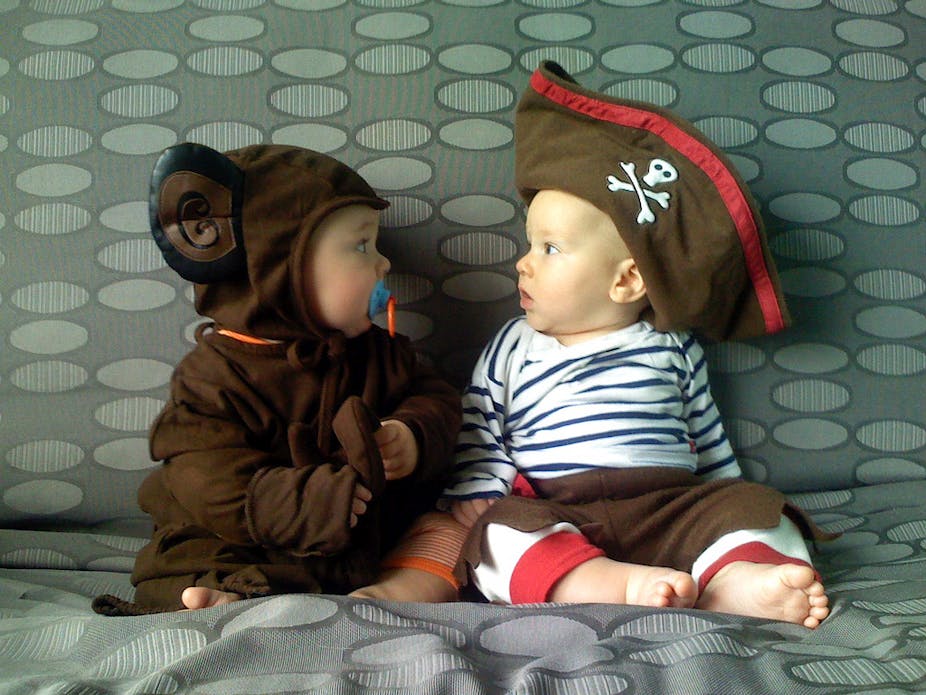We all know the scene: a child, wrapped in his or her own imaginary world, fights off aliens while flying through space on a rocket fashioned from an empty box. But could such flights of fancy be critical to humanity as we know it?
I published a paper earlier this week in the Journal of Comparative Psychology where I argue that the emergence of childhood (which I would broadly define as between two and seven years old) as a life stage may have been an important step. Here’s why.
Since the split from our common ancestor, the chimpanzee, seven million years ago, we have colonised more of the planet’s terrestrial habitat than any other species and account for about eight times as much biomass as all other terrestrial vertebrates combined.
Chimpanzees, by contrast, have been pushed to the brink of extinction. Why? What has led to our remarkable success, leaving all other species in our, at times devastating, wake?
There are many answers. But a stand-out candidate is that, unlike other animals, we not only pass on from one generation to the next a vast array of skill and information, but as we do, we define it, reinvent it and make it better.

This is what has become known as “cumulative culture”, and ours is the only species to show it.
But saying that cumulative culture is the key only provides a partial answer. More critical is to detail what, in the seven million years we followed different evolutionary paths, led us to develop cumulative culture and chimpanzees not to.
A cornerstone of human cumulative culture is our overwhelming propensity for copying what others do. Research has shown that children will imitate extended action sequences shown to them by an adult, even if those actions clearly serve no functional purpose.
This is important given that children grow up in environments saturated with tools and objects they must learn to use, adopting a strategy based around exact copying may have fewer costs than attempting to selectively choose relevant components.
A propensity for copying everything is also a marvellous platform for all sorts of cultural information to be passed on.
But copying everything others do won’t allow anything new to be created. Fundamental to our progression as a species is our capacity for invention. We are constantly developing new and ingenious ways of doing things – and constantly providing new and ingenious answers to questions that once seemed beyond our reach.

Our capacity for creative thinking sets us apart. But it doesn’t just emerge in us as adults. It very likely finds its origin in the imaginative play that children engage in from very early in life.
When children play they pretend – they conjure brave new worlds and let their imaginations run wild. Without this glorious period of child play in which the imaginative mind can flourish, it’s hard to see how such a mind could emerge at all.
So we have two core traits that seem necessary for cumulative culture to emerge – a tendency for copying others with high fidelity, and time for play. Both of these are laid down when we are children.
So it may be the mind that gives rise to cumulative culture emerges only after being first established in the mind of the developing child.
Creating childhood
This, of course, relies on the existence of a childhood in the first place and human life history, unlike any other animal, incorporates a lengthy period of dependency that begins after weaning and continues until self-care becomes possible at around seven years.
When might this species-specific life stage have become established? Shortly after divergence from our common ancestor with chimpanzees? Some time sooner?
A modern human-like sequence of dental development, as a proxy for the pace of life history, is regarded as one of the diagnostic hallmarks of our species. We can look at fossil teeth to get a picture of when childhood may have emerged in our evolutionary past.

In contrast to microscopic analysis of growth patterns in fossil teeth from other hominin species (e.g. Homo erectus) analysis of dental development in fossilised Neanderthal teeth is suggestive of a childhood in this species.
That is, childhood may not have emerged until after 300,000 years ago. Before this, there would have been a much more direct transition from infancy and breastfeeding to independence, as is the case for modern chimpanzees.
Crucially, this possible emergence of childhood coincides with the appearance in the archaeological record of rapid leaps in technological innovation in the construction of stone tools, and the emergence of clearly identifiable regional and stylistic variants indicative of true cultural traditions and culture areas.
We see signs of something like our cultural mind emerging around the same time we see signs of childhood emerging.
In sum, imitation and pretend play are critical developmental domains in the evolution of human cumulative culture. These domains became firmly established in the human mind and flourished only because the Homo line developed extended childhood as a life stage.
So next time you see a little one being a copycat or pretending to be an astronaut, take the time to reflect that, without these things happening, we may have never got to the moon.

